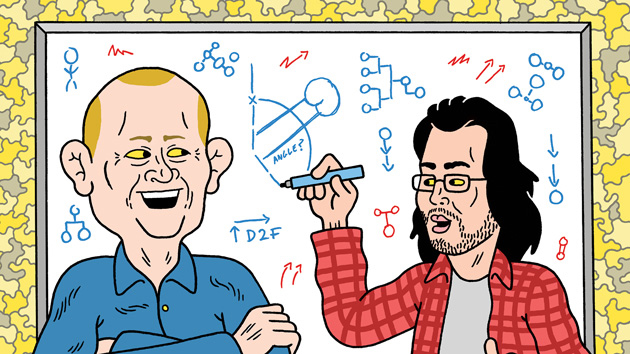Ali Paige Goldstein/HBO
The staff of Mother Jones is rounding up the decade’s heroes and monsters. Find them all here.
Living in the Bay Area is a mind fuck. To live here, you have to find a way to laugh in order to keep from crying.
Enter HBO’s Silicon Valley.
The sitcom, which premiered in 2014, channeled the absurdity of tech culture to tell the story of a motley crew of socially-awkward developers who want to change the world (obviously). The gang is driven by a blind, Zuckerbergian ambition to channel their passion for coding to create a revolutionary idea out of thin air while their company, Pied Piper, encounters the familiar pains of growing too big too quickly with venture capital money flowing all over the place.
Kara Swisher, who has guest-starred on the show, recently got to the heart of a consistent theme not just in Silicon Valley but also the real Silicon Valley, in a column for the New York Times:
The real problem, which was perfectly depicted on Silicon Valley, is that thoughtlessness is a feature, lack of reflection is a feature, a drive to grow at all costs is a feature and, most of all, the sloppy and lazy ways in which tech too often designs and deploys its inventions are the ultimate features.
What made the show compelling is its profound research and thoughtfulness about the most ridiculous aspects of the tech industry. It’s fitting that Veep, the political satire led by the incomparable Julia-Louis Dreyfuss, ran nearly parallel with Mike Judge’s Silicon Valley, two shows that gave us deeper insight into consequential yet comical worlds. Just as Veep upbraided Beltway ambition, Silicon Valley pokes fun at the outsized desires of the tech elite and offers a measure of hope for the gullible geniuses like Pied Piper‘s founder Richard Hendricks who want to make the world a better place.
And yet, it’s clear that even Hendricks could follow the path of a Mark Zuckerberg when he goes before Congress to make the case that his company would defy what other companies do and refuse to mine data, even though, he later finds out, they’ve been mining user data all along. It’s perfect that his nemesis, Gavin Belson, is a composite of tech billionaires. Silicon Valley, the show, thrived on the contradiction between an authentic belief of changing the world and just making money, just like the Patagonia vest-wearing tech bros who amble along Market Street do.











